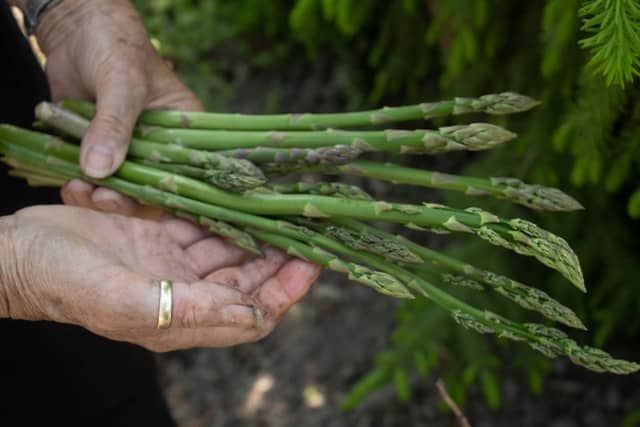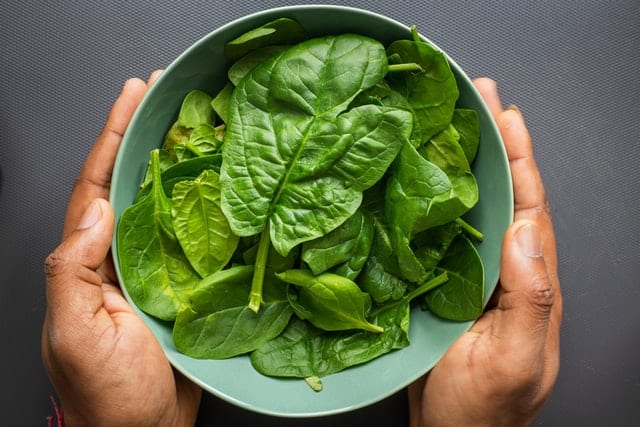
Dietitian’s Top 5 Spring Produce Picks
Spring produce is abundant and oh so fresh! Consequently, if you’re browsing your local farmer’s market or grocery store, be sure to look for spring produce options and support our outstanding farmers. In today’s blog, I will highlight my top 5 spring produce picks along with their nutritional benefits, and how to use and store them for maximum freshness.

Discover what’s available in Spring Produce!
Top 3 Reasons to Eat Seasonally:
- Saves money because these foods are in peak supply and without expensive transportation costs.
- Enjoy some of the best-tasting foods that are picked at peak freshness.
- Supports the local economy and our farmers.

Have you thanked a farmer?
What’s In Season in Spring in Ontario?
Beginning of spring (early April) fresh rhubarb is in season. Then by May to June, we start to see fresh berries, many leafy greens along with asparagus. There are also peas, beans, beets and cherries to name a few more. But my favoruite 5 spring produce picks include: asparagus, strawberries, radishes, cherries and local spinach. Let’s explore each below!
5 Spring Produce Picks!
1. Ontario-Grown Asparagus
Growing Season: May to June

Discover more about asparagus!
Nutrition on Asparagus
One serving of asparagus (1/2 cup cooked or approximately 5 spears) contains:
- 20 calories.
- 30% of your daily folate, which helps to build new red blood cells and prevents birth defects.
- 3 grams of fibre per serving to keep you feeling full and control blood sugars.
- A variety of other vitamins and minerals such as: vitamins A, C, K as well as iron, potassium and calcium.
How to Cook Asparagus?
- Grill on the BBQ.
- Roast in the oven (try my Crunchy Garlic & Parmesan Roasted Asparagus).
- Steam in microwave or on stovetop to make our Dijon Cream Sauce Asparagus.
- Add asparagus to pasta sauce, cold salad, soups, stir-fry, also goes great with egg dishes.

Here’s our Spring Fresh Gnocchi in Cream Sauce recipe!
How to Store Asparagus?
- Store asparagus standing with the bottom of stock in water. Can be stored for 4 to 5 days in fridge
2. Ontario Radishes:
Growing Season: May to November

Discover more about radish nutrition below!
Nutrition of Radishes
One serving of radishes (1/2 cup sliced):
- 10-15 calories.
- Provides 20% of your daily vitamin C requirement. Vitamin C helps in the growth and repair of bones, teeth, skin and acts as an antioxidant that may reduce risk of certain cancers and chronic diseases.
- Contains 1.5 grams of fibre per serving.
- Contains a small amount of B vitamins, calcium, magnesium and potassium.
How to Enjoy Radishes?
- Enjoy raw or cooked.
- Add on top of a salad with crunchy ingredients like apples, celery or walnuts.
- Include in veggie platter or charcuterie board.
- Add to soups, stir-fry’s or casseroles.
- Mix radish greens into your salad or sauté them with garlic and olive oil.

Want to learn more about building the best charcuterie boards?
How to Store Radishes?
- Store unpeeled radishes on their own (remove the greens).
- Place radishes in plastic bag or vegetable crisper.
- Last in the fridge for at least a week.
- The greens can be cleaned and stored in a plastic container for 3 to 5 days.
3. Ontario-Grown Strawberries
Growing Season: June to July

Learn more about strawberries below!
Nutrition of Strawberries
One serving of strawberries (1/2 cup sliced or 1 cup whole):
- 50 calories.
- Excellent source of vitamin C with 160% of your daily requirement.
- Contains 3.5 grams of fibre which helps in feeling full and reducing risk for heart disease.
- Contains the antioxidant, anthocyanins which helps in the prevention of diabetes, cancer and heart disease.
How to Use Strawberries?
- Enjoy strawberries either raw or cooked in jams.
- Eat strawberries on their own for a snack or dessert.
- Add to salad, smoothie or yogurt parfait.
- Add to homemade baking (pies, muffins).

Check out our Strawberry Swiss Salad recipe!
How to Store Strawberries?
- Stores in the fridge for 3 to 5 days.
4. Ontario Spinach
Growing Season: June to July

Check out the nutrition of spinach below!
Nutrition of Spinach
One serving of spinach (1/2 cup cooked or 1 cup raw):
- 10-20 calories.
- 60% daily recommended vitamin A; important for vision, skin &immunity.
- Cooking spinach increases antioxidant amount.
- Three cups of raw spinach has 90mg of calcium, whereas one cup cooked has 260mg!
- Contains potassium, vitamin K, iron, folate, magnesium & vitamin C.
How to Use Spinach?
- Eaten either raw or cooked.
- Spinach salad (try my Spinach Salad recipe with strawberries and feta cheese).
- Sauté spinach in stir-fry, or add to soup, sauces, casseroles or baking.
- Spinach pesto in your sandwiches or on your pizzas.
- Spinach dip.
- Add to smoothie.

Perhaps you’d like to try Spinach Lemon Ricotta Pancakes?
How to Store Spinach?
- Unwashed spinach lasts for about 4 days in the fridge.
- Can also buy frozen.
5. Ontario Cherries
Growing Season: June to July

Learn more about cherries below!
Nutrition of Cherries
One serving of cherries (1 cup):
- 50 calories.
- Contains 26% of your daily vitamin A, which is important for vision, skin and immune system.
- Has 17% of your daily vitamin C requirement, which helps in the growth and repair of bones, teeth, skin and acts as an antioxidant that may reduce risk of certain cancers and chronic diseases.
How to Use Cherries?
- Enjoy raw or cooked.
- Add to smoothies, oatmeal, baking, salads.
- Add to yogurt parfaits.
- Fresh dessert option.

How to Store Cherries?
- Store unwashed in the fridge.
- Last for 4 to 7 days in the fridge.
- Cherries can be frozen.
Bottom Line of Top 5 Spring Produce Picks:
To celebrate the freshness of spring, be sure to add seasonal produce to your diet. After all, you can’t beat the freshness of buying in season, and you’ll be saving money and supporting local farmers as well. Lastly, share how you will be enjoying spring fresh foods this season!

For more in-season foods all year long, check out the Foodland Ontario Guide. Happy Spring, everyone!


